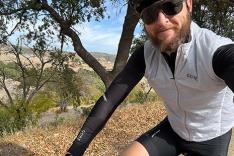
When you learn to ride a bike, pedaling is a distant second in importance to balance. As a child, you pedal simply to move forward. Once you conquer that without falling over, how you pedal—your upstroke and downstroke—gets lost in the details.
As an adult rider, especially if you're looking to improve your performance beyond commuting to the office—the minutiae of the pedal stroke and the idea of an efficient pedaling cadence becomes more important if you want to become a faster cyclist. Instead of just pushing down, you'll need to teach yourself to pedal evenly in smooth circles.
While this might sound easy enough, it can be a lot harder than you think. Use these tips and drills to correct your bad habits and become more efficient at pedaling your bike.
More: 23 Fun Facts You Didn't Know About the Tour de France
Work On Form First
The downstroke is where the majority of your power is generated, but improving your upstroke is where you'll see the most gains in your overall pedaling efficiency.
It used to be a common belief that the quadriceps are used in the downstroke and the hamstrings in the upstroke. Modern physiology shows that the ideal pedal stroke doesn't involve isolated muscle movements and that each segment of a pedal stroke involves multiple muscle groups.
The quadriceps, glutes, hamstrings and hips should all power the down stroke as a unit. For the most efficient full pedal rotation, the hips, glutes and hamstrings should work together to initiate the power of the upstroke as well. Without focusing on this proper pedal form first (i.e. spinning in circles), high-cadence drills can be a knee or hip injury waiting to happen.
More: Optimal Cadence: What's Right for You?
Find Your Cadence
As you begin to start cadence drills, you'll need to figure out your base cadence. Some people tend to be on the high end of the spectrum, while others are "grinders," or people who prefer to chug along in a larger gear with fewer revolutions.
An "ideal" cadence is between 85 and 95 revolutions per minute. Many professional riders such as those riding in Le Tour, can cruise along between 105 and 110 rpms because their cycling efficiency is so incredibly strong. For a beginner or a cyclist looking to improve efficiency, pedaling around 90 rpms on a long ride is a good goal to begin with.
You should have a bike computer with a cadence sensor so you don't have to guess your cadence. If you don't have a computer, there are many different formulas you can use to determine your cadence per minute. One of these is to count how many times your right knee lifts up in a 30-second period, then double it to find your rpms.
- 1
- of
- 2
About the Author









Discuss This Article